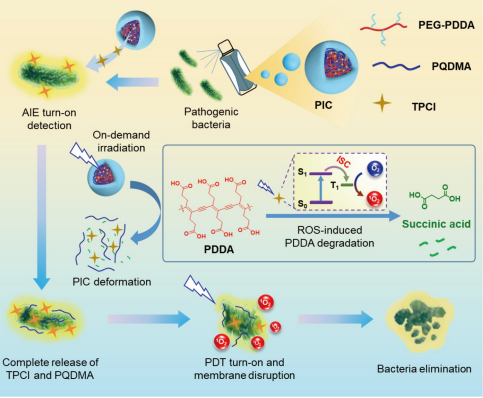Supervisor of Doctorate Candidates
Supervisor of Master's Candidates
Gender:Male
Status:Employed
Department:School of Life Science and Technology
Education Level:Postgraduate (Doctoral)
Discipline:Biomedical Engineering
Paper Publications
Polydiacetylene-based poly-ion complex enabling aggregation-induced emission and photodynamic therapy dual turn-on for on-demand pathogenic bacteria elimination

Indexed by:Journal paper
Journal:Science China Chemistry
Volume:65
Issue:9
Page Number:1782-1790
Key Words:poly-ion complex ROS responsive polydiacetylene photodynamic therapy aggregation-induced emission
DOI number:10.1007/s11426-022-1317-0
Date of Publication:2022-08-16
Impact Factor:10.138
Abstract:Poly-ion complex (PIC) integrating non-antibiotic theranostics holds great promise in the combat against drug-resistant bacteria. Photosensitizers with aggregation-induced emission (AIE) characteristic are particularly intriguing theranostic agents, but incorporating them into antibacterial PIC to enable both fluorescence and reactive oxygen species (ROS) generation turn-on deems a great challenge. Here we report the development of a PIC that can dually boost the fluorescence and ROS generation in the presence of pathogen bacteria. The PIC is constructed based on an anionic polydiacetylene poly(deca-4,6-diynedioic acid) (PDDA), which completely degrades in the presence of ROS. A cationic polymer quaternized poly(2-(dimethylamino)ethyl methacrylate) (PQDMA) that can disrupt bacterial membrane is co-loaded together with a highly efficient AIE photosensitizer TPCI in the PIC. PIC is nonfluorescent initially in that PDDA can quench the AIE of TPCI in PIC. When pathogenic bacteria are present, they can disturb the assembly of PIC to release TPCI, the fluorescence of which turns on sensitively to indicate the existence of bacteria. The on-demand irradiation can be subsequently applied to excite TPCI, which generates ROS to degrade PDDA and deform the PIC. As a result, TPCI and PQDMA are completely released to eliminate bacteria through a synergy of turned-on photodynamic therapy (PDT) and membrane disruption. The highly efficient detection and inhibition against both Gram-negative and Gram-positive bacteria have validated this polydiacetylene-based PIC system as an effective non-antibiotic antibacterial theranostic platform as well as a new strategy to enable “turn-on” fluorescence sensing and imaging of AIE fluorophores.
Links to published journals:https://link.springer.com/article/10.1007/s11426-022-1317-0
